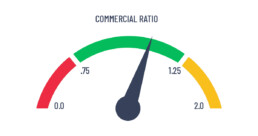The Commercial Ratio is the one number that measures the overall health of an entire commercial system.
Why the Commercial Ratio is important
Okay, we’ll say it: Commercial systems are inefficient and outdated. Today, the accountability and responsibility for driving a commercial system is broken down into organizational silos and distributed across too many people. As a result, businesses are generating overwhelming amounts of uncoordinated activities that overload salespeople and confuse customers. Unfortunately, due to a lack of overall process, most executive teams look at the wrong data and misdiagnose the problem… or just blame it on sales.
What is the Commercial Ratio?
The Commercial Ratio measures the overall performance of a commercial system. Your commercial process is an ecosystem with many moving parts. Without a standard way to measure the effectiveness of your commercial system, too much noise is created and your customer fails to understand and appreciate the economic value that your company can provide.
Developed in collaboration between our professional services team at Growth Enablement and private equity firm TCV*, the Commercial Ratio is a measure of productivity. The purpose of the Commercial Ratio is to help businesses improve their performance by becoming more efficient with their sales and marketing spending. By realizing that sales and marketing are both functions responsible for revenue growth, this metric indicates how efficiently (or inefficiently) your commercial system is creating value for customers.
In 2020, more than 57 companies adopted the Commercial Ratio as their primary metric to evaluate the productivity of their sales and marketing efforts in the commercial process. Although most of the early adopters are subscription-based technology businesses, the metric is designed specifically to measure the productivity of the value communication process in B2B businesses.
How to calculate your Commercial Ratio
The Commercial Ratio is a simple equation to measure productivity and understand how well your commercial system is performing creating value for your customers.
- Take the annual revenue of the previous year and subtract it from your current annual revenue. This is Revenue Growth.
- Divide your Revenue Growth by your current total expense for Sales and Marketing. This is your Commercial Ratio.
What your Commercial Ratio means
Below .75: Your system is unsustainable. Like the majority of companies, the Commercial Ratio is low because your company is investing more money in sales and marketing than it should. If you run your commercial system at a low commercial ratio, you have created an increasingly rigid and siloed organization unable to respond to changing market conditions.
Between .75 and 1.25: Congratulations. Your system is optimized, and your resources and results are balanced. You have minimal internal conflict, and are proactive in anticipating changing customer needs.
Over 1.25: You’re one of the few companies operating with this ratio. But don’t rest on your laurels just yet. You are probably being too risk-averse and could challenge your organization to invest in entering new markets or capturing more market share. Stay open to innovation.
Why CFOs love the Commercial Ratio
The primary reason sales and marketing functions exist is to drive revenue growth. While it is true some sales and marketing resources are invested to help renew existing business (think about account manager roles who up-sell existing accounts), the purpose of this ratio is to look at the aggregate return on a business’s sales and marketing investment.
Using the Commercial Ratio forces companies to shift their thinking from managing sales and marketing as separate cost centers to managing them as investments in commercial growth.
Rolling up all sales and marketing spending into one metric allows companies to evaluate:
- The investment in sales and marketing resources (helps track the effectiveness of execution)
- How well activities are prioritized (helps manage random acts of sales support)
- How well resources are aligned given results achieved (helps evaluate the ratio of headcount to results and if they are deployed effectively)
- The efficiency of the investment in driving revenue growth year over year
It also focuses the combined efforts of everyone involved in sales and marketing to drive revenue growth.
How to improve Your Commercial Ratio
When a Commercial Ratio is less than 1.0, the expense required to generate that new revenue growth must be recovered in future years of operation to meet investor expectations. With each consecutive year that this happens, more and more debt is pushed to other operational elements of the business, creating more stress across the business. In the end, the only reliable level is to cut costs, which creates a vicious cycle.
A healthier, more sustainable approach is to develop a go-to-customer strategy and improve communications that enable customers to buy complex solutions.












